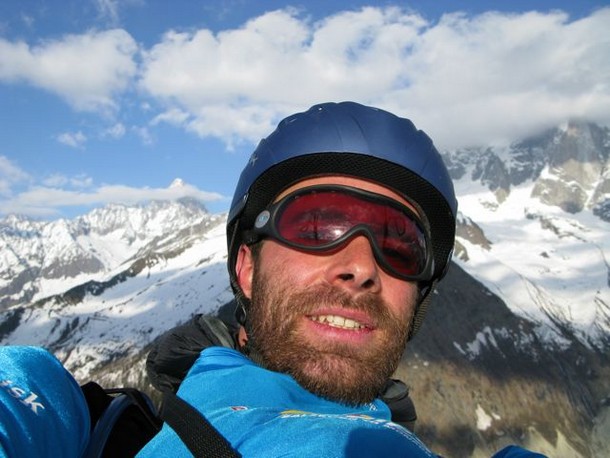
Tom Payne during a 169 km FAI triangle in 2010.

About this article
Tom Payne describes the flight where caught in wave, he feels he came closest to a fatal accident on a paraglider.
Pilot profile
Expert. International competition pilot and X-Alps competitor.
Flies many big XCs in the alps.
Developer of some popular paragliding apps (eg XC Planner)
24 Nov 2006
Original post on the PG forum.
01 Feb 2016
Added to Knowledge Base with Tom's kind permission.

Wave is fairly common in the Welsh Borders in the UK where I used to live, and I've flown gentle wave in my paraglider several times.
But this is a different story.
I met real mountain wave in my paraglider a few of weekends ago, in Saas-Fee in the Swiss Alps. It was the closest I have come to a fatal accident in a paraglider.
A friend and I had gone to do a bit of early season glacier skiing and had thrown our gliders in the back of the car on the off chance of flyable weather. On the Sunday the lift queues were interminable and the skies were blue so we decided to fly down from the top station (3500m) to the village (1900m). Jon was flying his Baby Boomer with his normal kit and I was flying my Aspen with my lightweight harness (no reserve). There was only one cloud in the sky, a distant cumulus over the Bernese Oberland which looked a little rounded and could have been a lenticular but in our valley everything looked fine so we disregarded it.
The take off on snow was uneventful, with a gentle cross wind but nothing too tricky. Jon lobbed off first and I followed a few moments later. There didn't seem to be enough wind to soar the upper ridges near the lift station, but secretly I hoped for a gentle thermal on the far, sunny slopes above the village. However, the atmosphere felt very stable so I resigned myself to a spectacular top-to-bottom flight over the dry glacier and scree slopes leading down to the resort.
Paragliding from the Weissmies (4023m) above Saas Fee. l On Vimeo l
Jon was a few hundred metres ahead of me, just flying over the headwall of the glacier when he hit lift. "Wa-hey," I thought, "we can soar!". But Jon kept accelerating upward while flying straight, climbing so quickly now relative to me that I looked down at my vario thinking that it must be me in driller sink but my sink rate was normal. Still without turning, I saw Jon fold in big ears, now climbing upwards and backwards. "Oh shit," I said, "this is going to be interesting." Anticipating the strong lift I struggled to push my speed bar, but I couldn't get it to grip against my slippery plastic ski boots. Ready on the brakes, I flew over the glacier headwall and prepared myself to be catapulted into orbit.
But I didn't hit lift. I hit rotor. Pure, evil, mountain wave rotor. The glider thrashed above me and I immediately knew I was in a very bad place. The left wing collapsed 30%, then, before it could recover, the right wing collapsed 40%, then the left wing collapsed further. I fought to control the wing, but this wasn't the localised turbulence that you find on the edge of a thermal. I was in a washing machine, about to be chewed up and spat out as a tangled mess of wing, line, and pilot. The wing surged, dived, re-opened, twisted and span. I looked from my harness to the wing and saw a full riser twist and the wing at the horizon, the glacier beyond.
Over the deep crevasses and exposed broken rock, cliffs and scree slopes there was to be no survivable landing, not even under a reserve parachute, which I didn't have anyway. My single thought was quite clear: "This is serious."
With no recourse but to fix the wing before I ran out of altitude I focused on the task at hand. There was only a single twist in the risers and I found the brakes still worked. The increased airspeed and wing loading of the spin had re-opened the glider so I steered it out as if I was coming out of a spiral dive, against the twists so that they unwound as I exited the spiral. The final half turn flipped me round as the wing came overhead. Without hesitation I reached up for the big ears and somehow managed to push the speed bar despite my plastic ski boots.
The wing continued to thrash, roll and collapse with the ears in, but the increased wing loading of big ears and bar kept it above my head. With suddenly a moment to spare I looked around to see what had happened to Jon. He was below me, near the upper middle ski station. Finding himself going upwards, backwards and being blown into Italy in strong mountain winds he had rapidly assessed his options: he wasn't going to make progress against the wind, with big ears in he'd still end up behind the knife-edge alpine ridges, a reserve would have brought him down in the next valley in rotor.
The only option was to escape the lift before he got blown back. So he spiraled for his life. A full-on, nose-down spiral that got him down and out. He didn't stop until he was close to the ground and well away from the awful wave.
Together we limped towards the resort and the beckoning safety of the golf course landing field. My wing, with ears and speed bar, continued to collapse but it seemed somehow trivial compared with what I had experienced in the twisted spin.
Jon was doing a better job of managing his wing, and eventually we spiraled down to touch down within a few metres of each other on one of the greens in light, pleasant winds.
Somehow the world of the mountain wave seemed far away as we lay in the warm grass cursing our stupidity and feeling lucky to be alive. We stared back up towards the glacier: of course, you couldn't see the boiling pot of turbulence at the glacial headwall. It was strange to have such a close brush with death and yet emerge unscathed. Above us the wave bars were now clearly visible and rotor cloud foamed from the peaks around us.

What have I learned?
Without a doubt, my life was saved by the SIV course that I did earlier this year. On the first day of the SIV course I was nervous, messed up an asymmetric collapsed and ended up in a twisted spin. Thanks to this experience, rather than panic and over-react, I was able to stay calm and focus on fixing the situation.
When I got home I looked at my GPS tracklog. The cascade lasted over a minute (including an impressive instantaneous 180-degree change of direction), but I lost very little height. I can only attribute this to the incredible luck of having my cascade in turbulent lift. Lucky. Very, very lucky.
We should have been more aware of the weather clues around us. We'd seen a lenticular, but ignored it. We knew that moderate winds had been forecast for that day, but we hadn't got an up-to-date forecast and had instead succumbed to the light winds on take off. We both have a renewed respect for mountain weather, and are grateful for a second chance.

Tom was asked...
on the Paragliding Forum if he'd checked the weather forecast before he went flying. He had and explains why he went flying and what he's learnt now.
Tom
Yup, in fact I'd seen a forecast a couple of days before that had predicted moderate N'lies in the area I was flying in for that day. My reasoning (which was completely wrong) was:
light wind on take off + stable conditions + in valley, below peaks + disregard forecast = light winds everywhere.
What I've learned now (from this and other experiences) is that stable atmospheric conditions in the mountains can actually be much more unpredictable and therefore dangerous than unstable (thermic) conditions.
My reasoning goes like this:
In unstable conditions:
- Clouds form, so you see what the wind is doing - all layers of the atmosphere mix, so if it's windy up high you'll feel it on the ground; wind speed varies less with height
- The usual system of valley and slope breezes sets up, so the conditions might be rough, but they are predictable
- Lots of pilots come out to play so you can talk to and watch other pilots
- You expect turbulence and plan your flight appropriately!
In stable conditions:
- Generally not many clouds or other gliders so fewer visual clues
- Little mixing of atmospheric layers, so wind speed and directions can be very different at different heights, so:
- If it's windy higher up then you won't feel it
- You can get large wind shear and wave effects that are unpleasant in paragliders
- You can even get caught out by stronger winds below you: valleys are narrower at the bottom, so if stability prevents the air rising over an obstacle the wind tends to speed up going around it
- You expect a gentle flight and might be less prepared for problems
Some experiences from a couple of autumns flying in the French Alps:
- Wind speed increasing massively with height: 0 km/h at 1700m, 20 km/h at 1900m, 45 km/h at 2100m over the Grand Arc
- Light winds on take off, strong winds in the valley bellow which put a friend in the trees (he couldn't penetrate against the wind to make the landing field) from the Dome de Bellcombe
- Wind directions varying by 135 degrees at different levels on the Grand Sure (S at the summit, NW 150m below)
- Mountain wave in Saas-Fee (write-up above)
- Wind much stronger or much lighter than forecast (several times)
Take care out there! Tom

l Knowledge Base l CSC Home |


